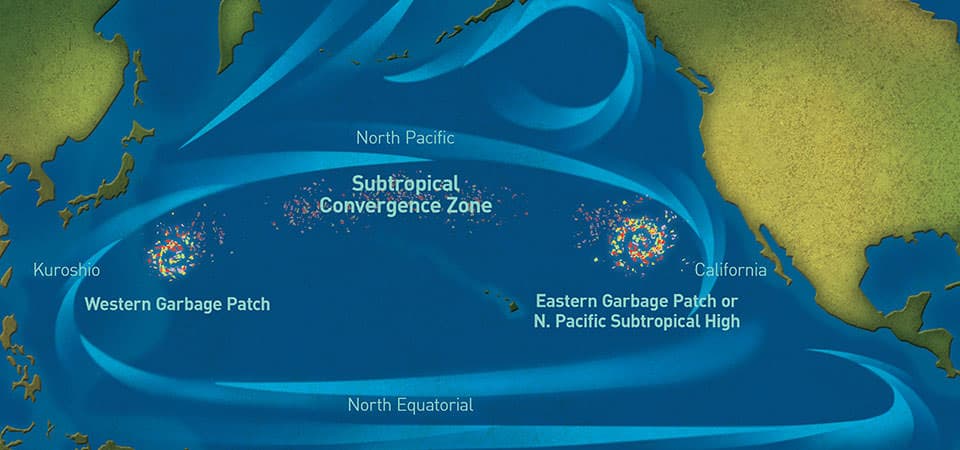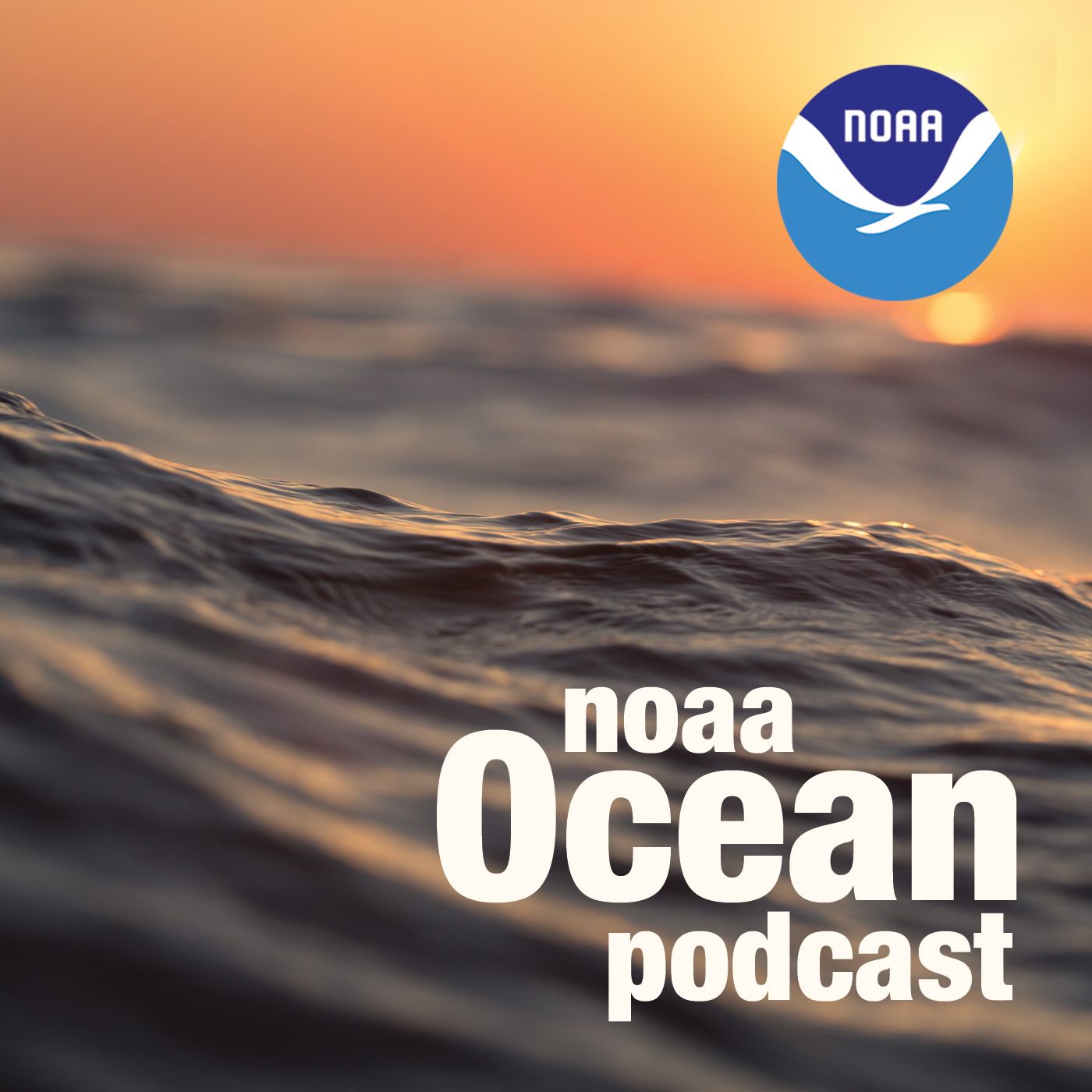Garbage Patches: How Gyres Take Our Trash Out to Sea
NOAA Ocean Podcast: Episode 14
How the gyres that circulate our ocean waters also accumulate plastics. Find out what a garbage patch is and isn't, and what we can do about this ocean-sized problem.

The most famous example of an ocean gyre’s tendency to "take out our trash" is the Great Pacific Garbage patch located within the North Pacific Gyre (shown here). While this is the most infamous garbage patch, it is not the only one in the ocean. Researchers have discovered two more areas where a “soup” of concentrated marine debris collects—one in the South Pacific Ocean, the other in the North Atlantic.
Transcript
HOST: You’re listening to the NOAA Ocean podcast… I’m Megan Forbes. In this episode we’re focusing on something that you’ve likely at least heard a little bit about in the last few years – Garbage Patches. Before we dive in to that specific subject, let’s take a step back to discuss the areas of the ocean where trash seems to collect. I’m talking about gyres.
Gyres are large systems of circulating ocean currents, kind of like slow-moving whirlpools. There are five gyres to be exact—the North Atlantic Gyre, the South Atlantic Gyre, the North Pacific Gyre, the South Pacific Gyre, and the Indian Ocean Gyre—that have a significant impact on the ocean. The big five help drive the so-called oceanic conveyor belt that helps circulate ocean waters around the globe. While they circulate ocean waters, they’re also drawing in the pollution that we release in coastal areas, known as marine debris.
The most famous example of a gyre’s tendency to take out our trash is the Great Pacific Garbage patch located in the North Pacific Gyre. The patch is an area of concentrated (and mostly plastic) marine debris. While this is certainly the most talked about garbage patch, it is not the only garbage patch in the ocean. In the last five years, researchers have discovered two more areas where a “soup” of concentrated marine debris collects – one in the South Pacific Ocean, the other in the North Atlantic. As with the North Pacific Garbage Patch, plastic can circulate in this part of the ocean for years, posing health risks to marine animals, fish, and seabirds.
How are patches like this forming in our oceans? What can we do about it? For the answer, let’s take a look back on a conversation between Troy Kitch and Dianna Parker as they discussed the details the most well-known garbage patch in the Pacific, of what a garbage patch is and isn't, and what we can do about this ocean-sized problem. Give a listen…
TROY KITCH: Dianna, welcome and thanks for joining us. Let's start with the obvious question: what are we talking about when we say 'garbage patch?'
DIANNA PARKER: A lot of people hear the word patch and they immediately think of almost like a blanket of trash that can easily be scooped up, but actually these areas are always moving and changing with the currents, and it's mostly these tiny plastics that you can't immediately see with the naked eye.
TROY KITCH: I noticed that you said garbage patch 'areas.' So the Great Pacific Garbage Patch is only one area in the ocean where marine debris concentrates?
DIANNA PARKER: There are garbage patches all over the world. These are areas where debris naturally accumulates. So there are garbage patches of all different sizes and shapes and compositions. The one that we know the most about is the Great Pacific Garbage Patch which lies in an area between Hawaii and California. What we know about this area is that it's made up of tiny micro plastics, almost akin to a peppery soup, with scattered larger items, fishing gear, those kind of items swirling around.
TROY KITCH: A peppery soup? Could you explain that again?
DIANNA PARKER: Well, imagine tiny, tiny micro plastics just swirling around, mixing in the water column from waves and wind, that's always moving and changing with the currents. These are tiny plastics that you might not even see if you sailed through the middle of the garbage patch, they're so small and mixed throughout the water column.
TROY KITCH: I would think that most of the plastics that ends up in the ocean are bigger pieces ... like bags and bottles and plastic toys. But you're saying that most of the plastic is so small that's it's hard or impossible to see. Can you talk a little more about the plastic debris in the ocean ... why it's so small?
DIANNA PARKER: There are many different kinds of plastics out in the ocean and they come from a number of different sources. So, there are teeny, tiny micro plastics out there that were either manufactured to be small — for example, the microbeads in face wash can be plastic; there are also little, tiny plastic pellets that we sometimes call ‘'nurdles' that are used to make larger items but then there are also tiny plastics that are shards of larger items. Plastics never really go away. They just break down over and over and over again until they become smaller and smaller from sunlight and other environmental factors [like] waves, big storms, those kind of things.
TROY KITCH: So we have these vast regions in the ocean where the water column looks like a peppery soup because of all these small bits and pieces of plastic. I would imagine this plastic kind of looks like food. Do we know if fish and birds are eating this stuff?
DIANNA PARKER: We know that some species of birds and fish eat micro plastics. They even eat some larger plastics. So for example, the Laysan Albatross in the Northwestern Hawaiian Islands, we know that just about every dead albatross found on Midway Atoll has some form of plastic in its stomach. We don't know if that's what killed it, but we know that this is becoming a big problem. So we know that there are micro plastics in the ocean. We know that birds and fish and even some larger marine mammals eat these plastics. We know there are chemicals in the plastics and we know that the chemicals can absorb other toxic chemicals that are floating around in the ocean. So now the big question is, what are those plastics doing to the animals that eat them.
TROY KITCH: I'm sure you get this question a lot: we know marine debris in the ocean is a bad thing ... so why don't we just clean it up? Especially if most of the trash is contained in 'garbage patch' areas because of the way the debris naturally accumulates because of ocean currents.
DIANNA PARKER: The words 'garbage patch' accurately describes what it is, because these are patches of ocean that contain our garbage. But they're not areas where you can easily go through and skim trash off the surface. First of all, because they are tiny micro plastics that aren't easily removable from the ocean. But also just because of the size of this area. We did some quick calculations that if you tried to clean up less than one percent of the North Pacific Ocean it would take 67 ships one year to clean up that portion. And the bottom line is that until we prevent debris from entering the ocean at the source, it's just going to keep congregating in these areas. We could go out and clean it all up and then still have the same problem on our hands as long as there's debris entering the ocean.
TROY KITCH: And that's really the big problem — to prevent the debris from entering the ocean in the first place. So what can you, me, or anyone do to help?
DIANNA PARKER: There's so much that we can do to keep debris from entering the ocean. It's as simple as changing your individual behavior every day, creating less waste, reusing what you can, remembering to recycle ... littering is obviously a no-no. And then going out and joining a beach cleanup. It's difficult to really understand the problem until you get out there and see it first-hand, how bad the problem is.
TROY KITCH: And I imagine you've had plenty of opportunities to go out there and see how bad it is first-hand.
DIANNA PARKER: I absolutely have. For example, every year I go out with the International Coastal Cleanup and work to pick up trash from the Anacostia and Potomac in Washington, DC, and the amount of trash you find on the shorelines is just incredible. Bottles, bags, aerosol cans, all mixed together. In some places it's like a thick mat. And so these are really populous, urban areas. But then we also see the same kind of trash on really remote beaches. For example, I was on beach in Lanai in Hawaii and we found everything from plastic bottles to flip flops, fishing gear, we found an entire couch. And some of this debris was clearly local and some of it had clearly come from other countries around the Pacific Rim. So debris can touch even the most remote places.
TROY KITCH: Given what you know, working on this problem day in and day out, I would think it would feel kind of like a hopeless, overwhelming problem.
DIANNA PARKER: It's not a hopeless situation. Marine debris is absolutely a solvable problem because it comes from us humans and our everyday practices. We can take any number of steps to keep it from entering the ocean.
HOST: That’s it for this episode of the NOAA Ocean Podcast. Thanks to Dianna Parker and Troy Kitch for helping us understand the science of garbage patches and how to help tackle this problem. To learn more about this science, or any ocean-related topic, visit our website at oceanservice.noaa.gov. We appreciate you taking the time to learn with us, and hope you’ll join us again soon. Until then…thanks for listening.

From corals to coastal science, connect with ocean experts to explore questions about the ocean environment.
Subscribe to Feed | Subscribe in iTunes
Browse All Episodes of the NOAA Ocean podcast